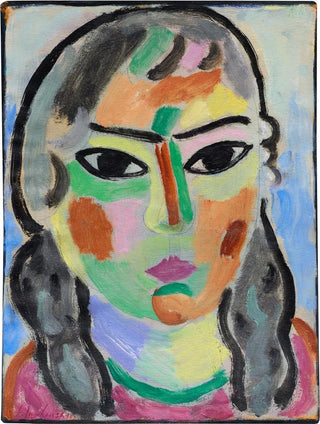Art print | Girl - Alexej von Jawlensky


View from behind

Frame (optional)
Art print Fille - Alexej von Jawlensky – Captivating Introduction
In the world of art, some works transcend time and space, captivating the mind and awakening emotions. "Fille" by Alexej von Jawlensky is one of those creations that, through its depth and delicacy, invites introspective contemplation. This iconic piece, part of the expressionist period, reflects the artist's quest to capture the essence of the human soul. Through stylized forms and vibrant colors, Jawlensky manages to evoke a range of emotions that still resonate today, making this work a must-have for art enthusiasts.
Style and uniqueness of the work
Alexej von Jawlensky's style is characterized by a unique approach that blends abstraction and figuration. In "Fille," facial features are simplified, almost geometric, while colors overlay to create an atmosphere that is both gentle and unsettling. The artist uses a rich palette, where warm and cool tones intertwine to produce a striking visual effect. The eyes, often the focal point of his portraits, seem to scrutinize the viewer, establishing a powerful emotional connection. The way Jawlensky plays with light and shadow gives the piece additional depth, inviting personal interpretation of the feelings it evokes. Every brushstroke is loaded with meaning, and this attention to detail helps make "Fille" a work of great singularity.
The artist and his influence
Alexej von Jawlensky, born in Russia and having found his artistic path in Germany, was a major figure in the expressionist movement. Influenced by Russian traditions and European artistic currents, he developed a style that is uniquely his own, blending spirituality and modernity. His work was enriched by encounters with other renowned artists, such as Wassily Kandinsky and Franz Marc, who also sought to explore the emotional dimensions of art. Jawlensky had a significant impact on his contemporaries and paved the way for new forms of artistic expression. By incorporating elements of Eastern culture and exploring human psychology, he succeeded in creating works

Matte finish

View from behind

Frame (optional)
Art print Fille - Alexej von Jawlensky – Captivating Introduction
In the world of art, some works transcend time and space, captivating the mind and awakening emotions. "Fille" by Alexej von Jawlensky is one of those creations that, through its depth and delicacy, invites introspective contemplation. This iconic piece, part of the expressionist period, reflects the artist's quest to capture the essence of the human soul. Through stylized forms and vibrant colors, Jawlensky manages to evoke a range of emotions that still resonate today, making this work a must-have for art enthusiasts.
Style and uniqueness of the work
Alexej von Jawlensky's style is characterized by a unique approach that blends abstraction and figuration. In "Fille," facial features are simplified, almost geometric, while colors overlay to create an atmosphere that is both gentle and unsettling. The artist uses a rich palette, where warm and cool tones intertwine to produce a striking visual effect. The eyes, often the focal point of his portraits, seem to scrutinize the viewer, establishing a powerful emotional connection. The way Jawlensky plays with light and shadow gives the piece additional depth, inviting personal interpretation of the feelings it evokes. Every brushstroke is loaded with meaning, and this attention to detail helps make "Fille" a work of great singularity.
The artist and his influence
Alexej von Jawlensky, born in Russia and having found his artistic path in Germany, was a major figure in the expressionist movement. Influenced by Russian traditions and European artistic currents, he developed a style that is uniquely his own, blending spirituality and modernity. His work was enriched by encounters with other renowned artists, such as Wassily Kandinsky and Franz Marc, who also sought to explore the emotional dimensions of art. Jawlensky had a significant impact on his contemporaries and paved the way for new forms of artistic expression. By incorporating elements of Eastern culture and exploring human psychology, he succeeded in creating works






